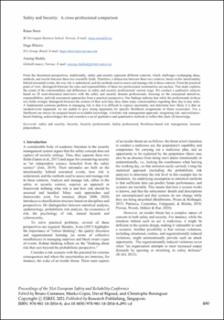Safety and Security: A cross-professional comparison
Chapter
Published version
Permanent lenke
https://hdl.handle.net/11250/3049694Utgivelsesdato
2021Metadata
Vis full innførselSamlinger
Originalversjon
10.3850/978-981-18-2016-8_091-cdSammendrag
From the theoretical perspectives, traditionally, safety and security represent different contexts, which challenges exchanging ideas, methods, and results between these two scientific fields. Therefore, a distinction between these two contexts, based on the intentionality behind unwanted events, the way risk is understood, and the methods used to assess and manage risk in these contexts. From the practical point of view, distinguish between the roles and responsibilities of these two professional communities are unclear. This study explores the extent of the commonalities and differences in safety and security professionals' current stage. We conduct a qualitative analysis based on 28 semi-structured interviews with the safety and security domain professionals, focusing on the conceptual narratives, responsibilities, and risk assessment approaches from a practical perspective. Our findings indicate that while the professionals in these two fields strongly distinguish between the context of their activities, they share many commonalities regarding their day-to-day tasks. A fundamental common problem in managing risk is that it is difficult to express uncertainty and determine how likely it is that an incident/event happened; we are unable to give strong arguments for specific likelihood assignments of threat occurrence. Yet, a likelihood can always be assigned based on available knowledge. A holistic risk management approach, integrating risk- and resiliencebased thinking, acknowledges this and considers a set of qualitative and quantitative methods to reflect this (lack of) knowledge.
